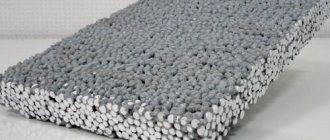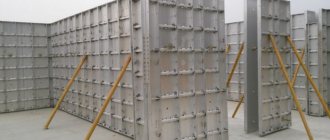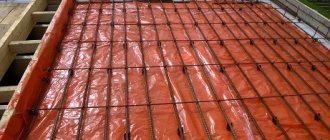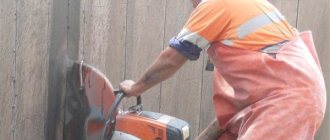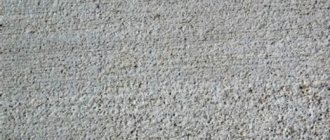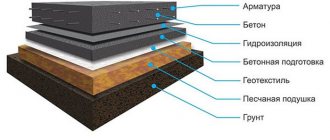The role of aggregates in concrete and mortars
These substances perform the following tasks:
- Reduce cement consumption . Such materials occupy a significant part of the volume of concrete mortar, making it more affordable.
- Increases the resistance of hardened concrete to cracking . Cement stone without such additives is more susceptible to splitting due to its tendency to shrink and deform. Modern aggregates play the role of a rigid skeleton of concrete, reducing its shrinkage several times compared to the shrinkage of cement without such additives.
- They increase the strength of hardened concrete mortar and improve the elastic modulus of concrete. A rigid skeleton made of aggregate minimizes deformation of the structure under load and reduces the creep of concrete. In this way, after hardening, the concrete solution is protected from the occurrence of irreversible plastic deformations of various types.
- Porous, lightweight aggregates reduce the thermal conductivity and density of concrete . Thanks to this, such a solution can be used to create enclosing or thermal insulation structures.
- Special hydrated and especially heavy fillers make concrete structures resistant to penetrating radiation .
Properties of hardened concrete.
Compressive strength.
This is the most important feature of concrete. The compressive strength of concrete determines the strength class.
Determined by the compressive strength of standard concrete cubes measuring 150x150x150 mm on the 28th day of curing in MPa. Strength can be measured on the cylindrical or cubic specimens mentioned above.
A). According to GOST, the following classes of concrete in terms of compressive strength are set: B3.5; AT 5; B7.5; BIO; B12.5; B15; IN 20; B25; B30; B35; B4Q-B45; B50; B55; B60; B65; B70; B75 and B80. For example, class B50 concrete has a compressive strength of at least 50 MPa.
b). According to the compressive strength of heavy concrete grade: M50; M75; M100; M150; M200; M250, M300; M350; M400; M450; M500; M550; M600; M700; M800; M900 and Ml000. Example - concrete grade M350 means that its compressive strength is at least 350 kgf/cm2.
Frost resistance of concrete.
This is the resistance of concrete, which is saturated with water, during repeated freezing and subsequent thawing. Named degrees of frost resistance: F25, F50, F75, F100, F150, F200, F300. After the letter "F" the number represents the number of freeze and thaw cycles that the concrete will maintain without losing significant weight and strength.
Waterproofness of concrete.
Determines the ability to resist the flow of water through concrete under pressure. This means that at a specified 10 times the volume of water pressure (in MPa) at which a 15 cm thick solid concrete sample does not show signs of water seepage.
Water absorption of concrete.
Indicates concrete in contact with water. Ordinary concrete water absorption is characterized by weight from 5% to 9%. As concrete absorption increases, its durability decreases.
Fillers for concrete: varieties
The grouping of such raw materials is based on the following factors:
- Grain size . According to this criterion, aggregates are distinguished: Large . This group includes materials with grains larger than 5 mm. Examples of such materials are crushed stone and gravel. They differ in the shape of the grains. Crushed stone consists of angular-shaped grains, gravel - rounded and rounded elements.
- Small ones . Fine aggregate is sand, the grain size of which is no more than 5 mm.
- Natural . Such materials can be obtained in three ways:
- Production directly at the field. Such aggregates can be immediately used to prepare concrete mortar.
Crushed stone/gravel
Crushed stone and gravel are natural coarse aggregates. Gravel is formed by the natural breakdown of rocks. Crushed stone is a product of artificial crushing. The use of these materials allows you to reduce concrete consumption and improve its performance properties. Fillers form a rigid frame and prevent cracks and shrinkage.
The grain size of the filler affects the further use of the building mixture. Concrete on fine-grained crushed stone is used to create small structures: elements of stairs, lintels, paving slabs. Coarse-grained compositions are used to prepare mixtures for the construction of strip foundations, reinforced concrete buildings, and retaining walls. The strength of the structures being built also depends on the size of the fractions. Concrete with the addition of fine gravel has a lower strength than mixtures with coarse aggregate.
Optimal characteristics of crushed stone:
- fraction - from 20 to 40 mm (coarse-grained), from 2 to 5 mm (fine-grained);
- type – granite;
- brand - M800;
- shape – predominantly cuboid with a flange content of no more than 10-50% of the total volume;
- cleanliness - free of dust and clay inclusions.
The lower the flake content in such a filler, the lower the cement consumption. A large number of clay inclusions in crushed stone affects the strength of concrete, reducing it by up to 30%. Granules that are too large will be difficult to mix even in a concrete mixer. Fractions that are too small will not provide sufficient strength.
Requirements for concrete aggregates
Occupying an impressive portion of the volume of concrete, aggregates have a great influence on its characteristics. Therefore, certain requirements are imposed on such materials. They are as follows:
- In aggregates (large and small), the ratio of grains of different sizes must fall within certain limits . In other words, any filler must have a certain grain (granulometric) composition. This requirement is determined by the need for maximum saturation of the mortar with aggregate grains. To determine the proportions of grains of different sizes in the material, sieves with cells of different sizes are used. The aggregate under study is divided into fractions. The obtained indicators are compared with the requirements of the standard.
- Any filler for concrete mortar should not have a negative effect on the hardening process of cement or impair the strength and durability of the hardened mixture . To fulfill this requirement, experts determine the degree of strength, frost resistance, resistance to various physical and chemical influences of aggregates, as well as their mineral composition and the characteristics of their grains.
- Aggregates must have a certain degree of purity . Silty, dusty particles envelop the surface of the grains of the material, reducing their ability to adhere to cement. This negatively affects the quality characteristics of concrete. Therefore, the proportion of dust and clay particles in coarse aggregate should not exceed 1%.
Research of aggregates is carried out using the sampling method. During this work, specialists take a certain number of individual samples from the material. The results of the study of these samples are averaged and applied to the entire volume of the aggregate being tested.
Grain composition of concrete aggregates
Sand
Sand is a fine mineral aggregate with a grain size of up to 3 or 5 mm (according to GOST 8736-58, grains larger than 5-10 mm are allowed to contain no more than 10% by weight).
Sand for heavy concrete must meet the following requirements:
Volumetric weight - not less than 1550 kg/m3 for concrete grade above 150 and for concrete exposed to freezing in a water-saturated state, 1400 kg/m3 for concrete grade 150 and below.
Grain (granulometric) composition of sand - the sifting curve should be within the shaded area (Fig. 5): coarse sand - closer to its lower boundary, medium sand - closer to its upper boundary. For fine sand, the screening curve lies between the shaded area and the upper broken line.
Table 53 - Grain composition of various sand groups (GOST 8736-58)
| Sand group | Size module | Total residue on sieve with mesh No. 063 in percent |
| Large | 3,5-2,4 | From 50 to 75 |
| Average | 2.5-1,9 | 35 — 50 |
| Small | 2,0-1,5 | 20 — 35 |
| Very small | 1,6-1,1 | 7 — 20 |
| Thin | less than 1.2 | less than 7 |
Thin sands are allowed only if the necessary feasibility studies are available in each individual case.
The content of grains passing through sieve No. 014 (189 holes/cm2) should not exceed 10% by weight.
The amount of dust and clay (silt) particles determined by elutriation should not exceed 5%.
The sand should not contain lumps of clay, loam or foreign contaminants.
Fig. 5 Grain composition graphs: a - sand; b - coarse aggregate.
The content of organic impurities is allowed in such quantities that the color of the liquid over sand treated using the dyeing method (GOST 8735-58) is not darker than the standard or, when tested with cement, gives a solution with a strength no less than a solution of the same composition and thus the same sand, but washed first with lime mortar and then with water.
When dosing sand, it should be taken into account that sand takes up the largest volume at a humidity of 5-7%.
Crushed stone and gravel
Crushed stone and gravel (GOST 8267-56, 8268-56) serve as large aggregates for concrete. In accordance with the specified GOST and TU for the manufacture and acceptance of prefabricated reinforced concrete and concrete products CH1-61, gravel and crushed stone from natural stone must meet the following requirements.
For concrete and reinforced concrete structures and parts, depending on the size of the structural sections and reinforcement, gravel and crushed stone of the following fractions should be used: 3-10, 10-20, 20-40, 40-70 mm. In some cases, mixing of two adjacent fractions is allowed. Instructions for the maximum size of crushed stone are given in table. 55.
Application of aggregates for concrete
Each type of aggregate imparts certain properties to the mortar, which ensures its use in certain cases. It is very important to correctly select the components of concrete in order to obtain a solution with certain technical parameters. The selection of such materials is carried out taking into account many aspects, including the type of concrete mixer used. When choosing it, its purpose is also taken into account, be it improving strength, making the solution resistant to heat and heat or the chemical effects of aggressive substances. If it is necessary to construct structures that are resistant to radiation, anti-radiation filler is used. Decorative concrete aggregate is used to create fences, aesthetically attractive structures and facades. Common aggregates - crushed stone, gravel and sand - are used to create most types of concrete solutions. This is explained by the fact that such materials give the mixture the necessary quality and strength characteristics.
Properties of concrete mixture.
Consistency of concrete.
Determines the degree of fluidity of a concrete mixture and illustrates its ability to deform under load.
The consistency is controlled by the content type and amount of chemical additives. In any case, it is impossible to adjust the consistency of the water content, since this may lead to significant changes in the properties of the concrete.
Applicability of concrete mixture.
This ability of concrete to maintain the homogeneity of the material with the least effort.
Manufacturability of use depends on the type of raw materials and additives, as well as on the time elapsed from mixing the individual components.
Resistance of concrete.
This property involves the compaction of water in a concrete mixture or cement mortar. This is most often caused by adding more water than the concrete mix provided in the recipe. This phenomenon is unfavorable because the concrete surface is very resistant to dust on the surface. This is especially undesirable on horizontal surfaces (floors, ceilings, screed).
Segregation (stratification) of concrete.
Segregation is the separation of the components of a concrete mixture in such a way that their distribution at the end of the mixture must be balanced: the aggregate of concrete settles to the bottom of the form and the mortar collects at the top. Segregation is a very negative phenomenon, as it leads to a decrease in the strength parameters of concrete.
